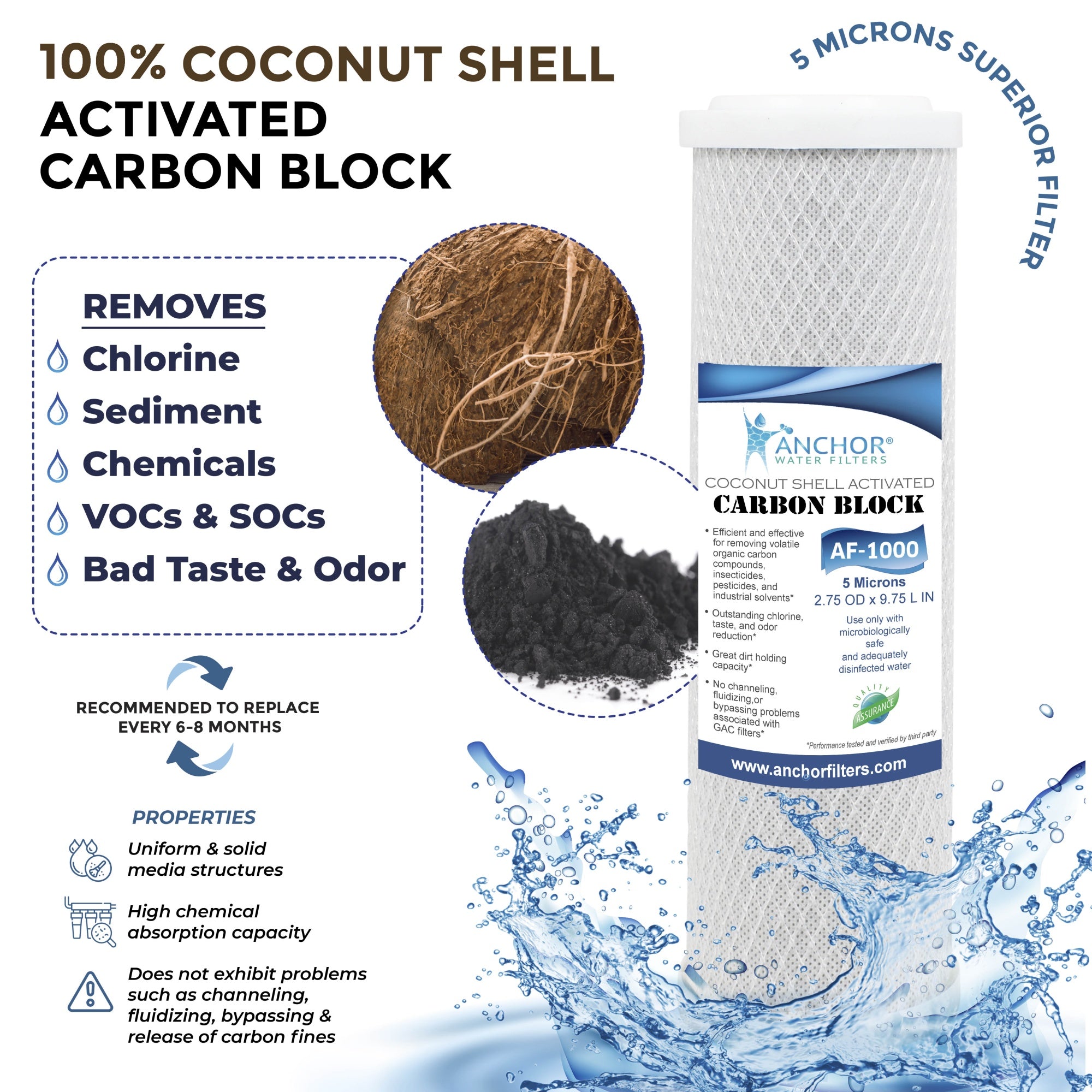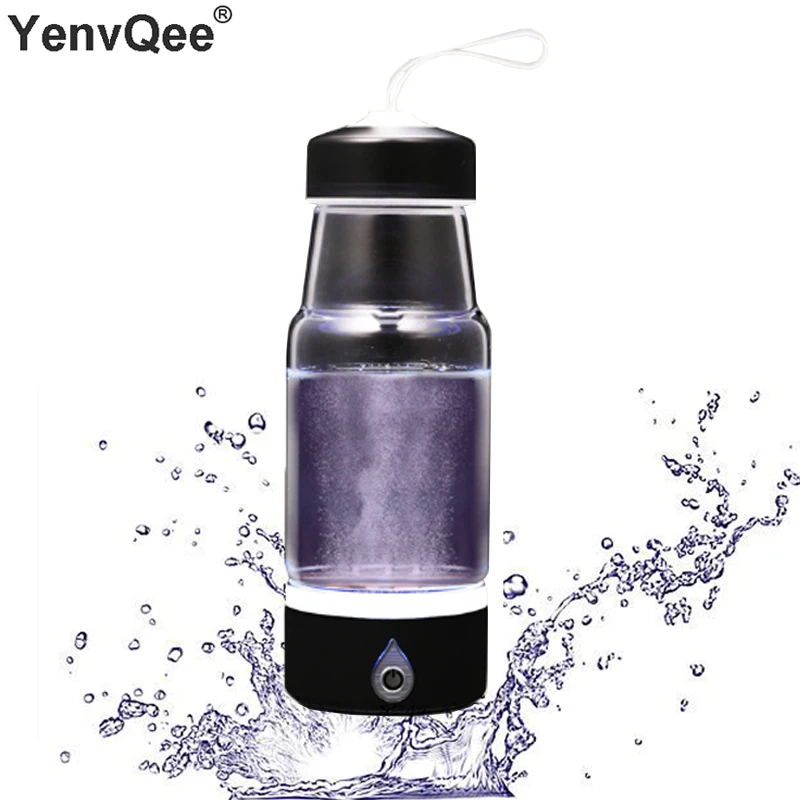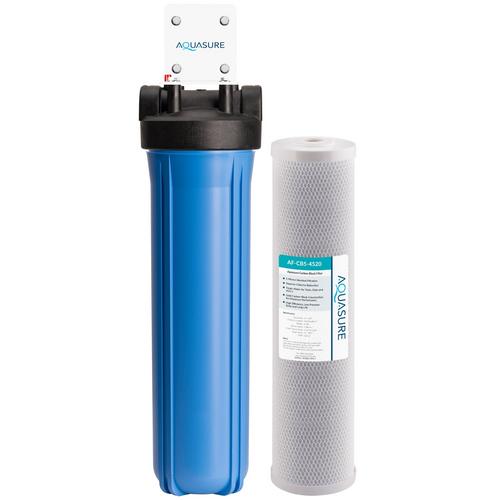What Is A Carbon Block Filter?
Think of a tiny black block as your personal water hero, scrubbing away impurities to give you crisp, fresh water. Back in uni, my roommate swore by a simple countertop pitcher with a carbon block filter—she claimed it turned the horror show of dorm tap water into something drinkable, and I was honestly skeptical until I tried it myself. A carbon block filter is made by grinding activated carbon into a fine powder, then pressing it under heat with a food-grade binder into a solid, porous block. This dense structure looks unassuming, yet within its labyrinth of microscopic channels lies an enormous surface area that water simply can’t resist exploring [3][5].
As water is forced through this compact matrix, larger particles get physically trapped at the entrance—like a microscopic sieve catching rust, dirt, and sediment—while chemical contaminants adhere to the carbon’s vast inner surface through adsorption. I find it comforting that such a simple piece of carbon works like both a net and a magnet at the same time, drawing in chlorine molecules, volatile organic compounds, and odd tastes or odors until the block is saturated [1][2]. The outcome? A jug of water that looks clear, smells neutral, and tastes downright inviting.
This kind of filter excels at capturing chlorine, sediment, VOCs, and the unpleasant whiffs that plague many municipal supplies, dramatically improving tap water flavor. It doesn’t remove dissolved minerals or salts, though, so it’s often paired with other technologies for truly comprehensive purification. If you’re curious how carbon blocks fit into a complete home system, have a look at our carbon water filter guide. Honestly, once you’ve sipped water that’s been through a carbon block, going back feels like drinking tap straight from the pipe—certainly not my first choice anymore.
How Carbon Block Filters Work
Water winds its way through a solid block of carbon, and along its journey two powerful forces work in harmony: mechanical separation and adsorption. Mechanical separation acts like a microscopic sieve, physically blocking rust, dirt, and sediment in the filter’s tight pores, so you’re left with water free of pesky particles [1]. Meanwhile, adsorption uses the carbon’s expansive inner surface—over 3,000 m² per gram—to attract and bind chlorine, VOCs, and odor-causing compounds as water snakes through the block [2].
The magic happens because the carbon block is created by compressing activated carbon powder with heat and a food-grade binder. As water is pushed through this dense, porous matrix, it first slams into tangled carbon granules, trapping particles in narrow channels, and then allows dissolved chemicals to cling to the carbon surface until the block reaches capacity [3]. It’s a zero-chemistry process—no electricity, no added chemicals—just plain old physical and chemical interactions that capture contaminants with surprising efficiency [4]. The next time you flip that tap and fill your glass, remember there’s a whole microscopic ballet happening inside that block.
Oddly enough, this isn’t rocket science, yet the performance rivals much more complex systems. It’s a testament to carbon’s unique properties: spongy pores for particles, sticky surfaces for chemicals. I once timed my kitchen sink filling for dinner prep, half-expecting an eternity—but the block’s design keeps flow reasonable while ensuring your water is as pure as possible.

Applications of Carbon Block Filters
From your kitchen tap to massive factory lines, carbon block filters quietly deliver clean, crisp water and beyond. In homes, these dense, porous blocks serve as the go-to choice for under-sink kitchen filters and whole-house systems, locking out sediment and chlorine before a single drop reaches your glass. Their tightly packed structure traps rust and particles, while the vast surface area adsorbs unwanted chemicals, VOCs, and off-tastes with impressive efficiency [1] and even tackles lingering odors in point-of-use setups [5].
Step into cafés, breweries, or corporate offices and you’ll find commercial carbon block units ensuring every espresso shot and ice cube meets high standards. Industries depend on multi-stage carbon trains to strip VOCs and chlorine, protecting boilers and processing equipment from corrosion and contamination [4]. Food and beverage plants lean on these filters to maintain consistency—from pasteurizing dairy to bottling soft drinks—while advanced water purification technology makes integration seamless in even the most complex setups advanced water purification technology.
I’m amazed by how carbon blocks extend beyond water: they slip into HVAC systems to trap airborne VOCs, fit into respirator masks for cleaner breathing, and even filter gases in biogas plants to remove siloxanes [2]. From sugar refining to coffee decaffeination, their versatile adsorption shows up in surprising places—proof that a simple block can deliver powerful, wide-ranging filtration. And who would’ve thought a chunk of charcoal could be so indispensable?
Contaminants Removed And Not Removed By Carbon Block Filters
Carbon block filters work like tiny magnets for chemicals, leaving fresh, clean water in their wake. With a tightly packed carbon matrix, these filters physically trap sediment and draw in chemical nasties like chlorine, VOCs, pesticides, and the molecules that cause off-tastes and odors in our tap water [1]. Thanks to an internal surface area exceeding 3,000 m² per gram, carbon block can adsorb up to 99% of free chlorine and a significant share of VOCs, dramatically improving water flavor and smell [2]. Many homeowners rave about clear glasses and coffee free from chemical edge.
However, not everything is caught in the block. Minerals like calcium and magnesium—the ones that make water “hard”—pass right through, as do common dissolved salts, nitrates, and even some heavy metals like lead unless special media are added [3]. If you test your water with our at-home fluoride kits, you’ll notice ionic contaminants largely untouched—underscoring the need for multi-stage systems when water quality is critical.
That’s why many setups pair a carbon block with membrane technologies such as what is reverse osmosis water filtration. Together, they cover the full spectrum: taste, odor, chlorine, VOCs, minerals, and nitrates—leaving water that’s safe, pure, and delicious. I’ve seen the difference firsthand in my kitchen; every drop tastes smoother, and I feel confident pouring a glass for the kids.

Carbon Block Vs GAC Filters: Key Differences
Choosing the right filter can feel overwhelming, but knowing how carbon block and GAC filters differ helps you pick the perfect match for your water needs. At their core, carbon block filters are solid, compressed blocks of activated carbon, while GAC (granular activated carbon) filters use loose granules held in a housing. The dense matrix of a carbon block slows water flow, creating longer contact time with the carbon surface, whereas GAC offers faster flow thanks to its looser packing and lower resistance [4].
Structurally, this difference means carbon block filters trap sediment more effectively in one go, while GAC may allow tiny particles to slip through during high-demand periods. Carbon blocks often outperform GAC in filtration efficiency; thanks to compact pores and massive surface area, they excel at adsorbing chlorine, VOCs, and other organics [1]. GAC filters still remove taste and odor, but shorter contact time and potential channeling reduce their overall effectiveness.
Typical uses diverge: carbon block filters shine in point-of-use systems like under-sink kitchen filters and reverse osmosis pre-filters, delivering crisp drinking water without unwanted particles. GAC filters, on the other hand, are great for bulk water treatment where flow rate dominates and minor fines aren’t a dealbreaker. Many homeowners pair a carbon block unit with a reverse osmosis stage—especially effective when tackling both sediments and dissolved chemicals in one fell swoop.
Benefits Of Carbon Block Filters
Feeling confident about every drop of water starts with knowing you’ve chosen the right filter. One of the standout perks is superior adsorption capacity: carbon block filters pack activated carbon into a dense matrix that offers over 3,000 m² of surface area per gram, pulling in chlorine, VOCs, and impurities like a magnet [1].
There’s also longer contact time. Because water must slowly weave through the tight carbon block, it spends more time interacting with the carbon’s surface—boosting removal of odd-tasting chemicals and stubborn pollutants. This principle often yields noticeably crisper water compared to looser GAC options [4].
High efficiency in contaminant removal rounds out the benefits: beyond trapping sediment, these filters excel at capturing bad tastes, odors, and harmful VOCs—often reducing levels by up to 99% [3]. They release almost no carbon “fines,” so your glass stays clear and grit-free [5]. Pairing them with other stages can create a turnkey purification solution for any home.

Limitations Of Carbon Block Filters
Carbon block filters can feel like heroes against chlorine and odors, yet they stumble when facing dissolved minerals and sometimes slow your water to a crawl. One key drawback is that tiny inorganic compounds—like calcium, magnesium, or nitrates—simply pass through the carbon matrix [2]. Unless a special media layer is added, heavy metals or salts remain largely untouched [3].
The dense design also slows flow rates, turning a simple glass fill into an exercise in patience—I used to tap my foot at the sink during dinner prep, waiting for each drop. To overcome these limits, many homeowners combine carbon blocks with a reverse osmosis stage or add dedicated pre-filters to boost flow and broaden contaminant removal.
Maintenance matters too. Carbon blocks need timely replacement—running them past capacity risks re-releasing trapped compounds back into your water. Still, when maintained properly, they remain among the most reliable defenders against taste- and odor-causing chemicals.
Efficacy Of Carbon Block Filters
Carbon block filters are made by compressing activated carbon into a dense, porous matrix, combining mechanical separation and adsorption to tackle contaminants head-on. The tightly packed structure physically traps sediment and rust while billions of microscopic pores capture negatively charged chemicals. This design delivers an enormous surface area—over 3,000 m² per gram—giving these filters their edge in removing chlorine, taste, and odor [1][2].
Whether it’s an under-sink installation or a point-of-entry setup, these filters excel at stripping out chlorine, VOCs, and even some pesticides, leaving water crisp and fresh. Families worried about taste and odor often notice a night-and-day difference once they switch. Yet, no filter is perfect—the dense structure can slow flow rates and, while carbon blocks release fewer fines than granular options, they still require regular replacement to maintain peak performance [4][5]. Pairing them with a reverse osmosis system creates a full-spectrum purification solution that tackles organics, minerals, and particles—so every sip is as pure as nature intended.
Citations
“`html
Complete Top Picks Comparison – 23 Products
| Product | Source | Price | Rating | Image | Buy |
|---|---|---|---|---|---|
| 8 Pcs Aquarium Cube Filter Activated Carbon Aquarium Filter Water Filter for Fish Tank 4 x 4 x 2 Inch Cube Honeycomb Structure Charcoal Deodorant for Ponds Pools Horses Stock Tank Filtration | Amazon | $23.99 | ★★★★☆ |  | Buy on Amazon |
| Brondell UF-15 Single-Stage Carbon Block Water Filter Replacement for Coral Under Sink Filtration System, Lasts 6 Months | Amazon | $49.99 | ★★★★☆ |  | Buy on Amazon |
| AO Smith 2.5″x10″ 5 Micron Carbon Block Sediment Water Filter Replacement Cartridge – 2 Pack – For Whole House Filtration Systems – AO-WH-PRE-RC2 | Amazon | $17.99 | ★★★★☆ |  | Buy on Amazon |
| Aquaboon 5 Micron 10 x 2.5 Carbon Block Water Filter Cartridge CTO Whole House Water Filter Replacement Compatible with WHKF-WHWC, FXWTC, 6-PACK | Amazon | $31.79 | ★★★★☆ |  | Buy on Amazon |
| ICEPURE 10″X4.5″,1 Microns Whole House Sediment Activated Carbon Water Filter Compatible with Dupont WFHDC8001,EP Series,EPM Series,CB-BB-10, GE FXHTC, GXWH40L, GXWH35F, GNWH38S, CTO10BB,1PACK | Amazon | $31.99 | ★★★★☆ |  | Buy on Amazon |
| iSpring FC25B Whole House Water Filter Replacement Cartridge, CTO Carbon Block, 20” x 4.5” | Amazon | $51.49 | ★★★★☆ |  | Buy on Amazon |
| QCRO Complete Replacement Filter Kit 50 GPD for Pura/Aqua flo | Amazon | $105.99 | ★★★★☆ |  | Buy on Amazon |
| iSpring FC15B High Capacity Activated CTO Carbon Block Filter for Under Sink and Whole House Water Filtration System, 5-Micron 10″x4.5inch | Amazon | $36.99 | ★★★★☆ |  | Buy on Amazon |
| Pentair Pentek EPM-BB Big Blue Carbon Water Filter, 10-Inch, Whole House Modified Epsilon Carbon Block Replacement Cartridge with Bonded Powdered Activated Carbon (PAC) Filter, 10″ x 4.5″, 10 Micron | Amazon | $44.97 | ★★★★☆ |  | Buy on Amazon |
| AO Smith 2.5″x10″ 5 Micron Carbon Wrap Sediment Water Filter Replacement Cartridge – 2 Pack – For Whole House Filtration Systems – AO-WH-PRE-RCP2 | Amazon | $17.00 | ★★★★☆ |  | Buy on Amazon |
| For Brita Maxtra Water Filters Cartridge Purify Kettle Activate Carbon Water Filter European Version Liner Is Not Available | AliExpress | $4.85 | ★★★★★ |  | Buy on AliExpress |
| A25F-Graduated Mason Jars Cold Water Jugs Glass Jug Sets Coffee Filters Handle Lids Glass Bottles | AliExpress | $30.95 | ☆☆☆☆☆ |  | Buy on AliExpress |
| 420ML Portable Rich Hydrogen Generator Cup Water Filter Ionizer Pure H2 Hydrogen alkaline Bottle Electrolysis Drink Hydrogen | AliExpress | $29.87 | ★★★★★ |  | Buy on AliExpress |
| New For Brita Maxtra 2PCS/6PCS Water Filters Cartridge Limescale Chlorine Impurities Purify Kettle Activate Carbon Water Filter | AliExpress | $9.91 | ★★★★☆ |  | Buy on AliExpress |
| SOUDRON Household 13L 6 stages drinking mineral water filter purifier for water dispenser | AliExpress | $37.09 | ★★★★★ |  | Buy on AliExpress |
| Tea Maker Wide Mouth Cold Brew Pitcher Beverage Container With Handle Leak Proof Infused Water Jar For Outdoor Studio Kitchen | AliExpress | $22.69 | ☆☆☆☆☆ |  | Buy on AliExpress |
| Replace Refrigerator Water Filter For everydrop by whirpool filter 2, EDR2RXD1 For Element W10413645A WRF989SDAB | AliExpress | $17.74 | ★★★★★ |  | Buy on AliExpress |
| DEYE 5KW 6KW On Grid Inverter SUN-5/6K-G05P1-EU-AM2 230VAC Single Phase 2 MPPT Low Start Up Voltage Of 80V Solar Charger | AliExpress | $170.78 | ☆☆☆☆☆ |  | Buy on AliExpress |
| New Samsung DA29-00020B, DA29-00020A, HAF-CIN EXP advanced refrigerator water filter 1 pack | AliExpress | $19.54 | ☆☆☆☆☆ |  | Buy on AliExpress |
| VTOMAN FlashSpeed 1000 Portable Power Station 2000W 828Wh LiFeP04 Battery For Outdoor Camping Tent Travel | AliExpress | $246.22 | ☆☆☆☆☆ |  | Buy on AliExpress |
| Brita New Sealed Large 10-Cup Water Filter Pitcher With 2 Standard Filters | eBay | $32.99 | ☆☆☆☆☆ |  | Buy on eBay |
| Waterdrop Chubby 10-Cup Water Filter Pitcher, NSF Certified,Long-Lasting 200 gal | eBay | $19.99 | ☆☆☆☆☆ |  | Buy on eBay |
| Waterdrop 200-Gallon Long-Life Water Filter Pitcher, NSF Certified,7-Cup, White | eBay | $14.99 | ☆☆☆☆☆ |  | Buy on eBay |
“`

